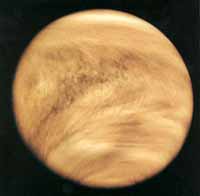Atmosphere of Venus
Of all the terrestrial planets, Venus has the thickest atmosphere and the slowest rotation rate.
One day on Venus is equal to 243.16 Earth days. This puts Venus in a class of its own, with Titan, the atmosphere-bearing moon of Saturn, as its only companion (rotation rate of about 16 days). Because Venus has no oceans to vary the surface heating, no tilt to its rotation axis, a nearly circular orbit around the Sun, no large scale topography, and a nearly uniform, global cloud cover, it seems its atmosphere would be easy to understand using only incoming solar radiation. Early models of the Venusian atmosphere suggested the winds should blow from the day side to the night side, and the day-night temperature difference could be large indeed.
Ground- and spacecraft-based observations tell us otherwise: the winds blow in essentially the same direction as the planet’s rotation (with a slight poleward component) at all observed latitudes and at all altitudes to about 100 km. It is only in the atmosphere above 100 km that the winds blow from the day-side to the night-side. Furthermore, the east winds and the poleward component generally increase with latitude to about 45 degrees. Poleward winds at this latitude in both the hemispheres and the east-west (zonal) and the north-south (meridional) winds decrease towards the pole. There is thus a peak in the angular speed of the atmosphere in two bands about mid-way between the equator of Venus and its poles – the equivalent of the terrestrial jet stream.
This global structure of the atmospheric motion organizes the Venus atmosphere in the form of two giant hemispheric vortices, one centered over each pole.






